EMEA Outlook: Mixed Prospects Due to Global Uncertainties and Domestic Dynamics
· In South Africa, we foresee average headline inflation will stand at 4.1% and 4.5% in 2025 and 2026, respectively, despite there are upside risks to inflation such as remaining power cuts (loadshedding), tariff hikes by Eskom, spike in food and housing prices, and global uncertainties. We see growth to be 1.6% and 1.7% in 2025 and 2026, respectively, and the key will be coalition’s determination tackling financing needs, loadshedding, and logistical constraints. Risks to the growth outlook are broadly balanced, with faster reform implementation representing an upside risk to growth while uncertainty about the U.S. economy, slowing China demand, and tariff wars could cause problems for growth. Our end-year policy rate prediction remains at 7.0% for 2025 and 6.5% for 2026.
· In Turkiye, despite fall in inflation in Q1, we foresee upside risks emanating from deteriorated pricing behavior, stickiness of services inflation, and adverse geopolitical impacts leading average inflation forecasts to stand at 32.1% and 20% in 2025 and 2026, respectively. We think Central Bank of Republic of Turkiye (CBRT) will likely cut the rate to 30% by the end of 2025. On the growth front, we forecast the economy to expand by 2.6% in 2025 and 3.5% in 2026 considering high inflation and tighter fiscal stance continue to dent GDP growth.
· In Russia, the war in Ukraine continues to create high military spending, strong fiscal stimulus in addition to aggravation of staff shortages. Our 2025 average headline inflation projection increased when compared with the December outlook from 7.4% to 8.6% due to an overheated economy. Our end-year policy rate prediction remains at 19% for 2025 and 12% for 2026 as we foresee Central Bank of Russia (CBR) to consider cutting rates late 2025 unless inflation picks up and RUB loses value significantly. We envisage growth to hit 1.6% and 1.5% in 2025 and 2026, respectively, which is less than 2024 figure considering a ceasefire in Ukraine, likely followed by a Russia-friendly peace deal will squeeze military spending and fiscal support.
Forecast changes: From our December outlook, we have lifted our 2025 average inflation forecast for Russia to 8.6% due to continued military spending. We now envisage Russia will consider reducing the policy rate in Q3/Q4 2025 as inflation come down from its peak. The key will be whether the war in Ukraine will come to an end in 2025 or not.
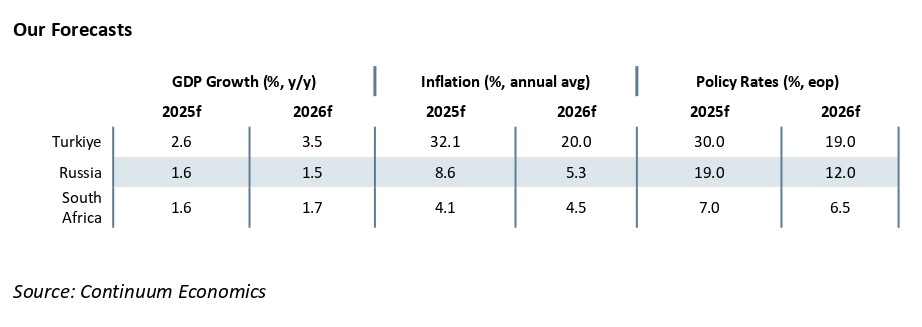
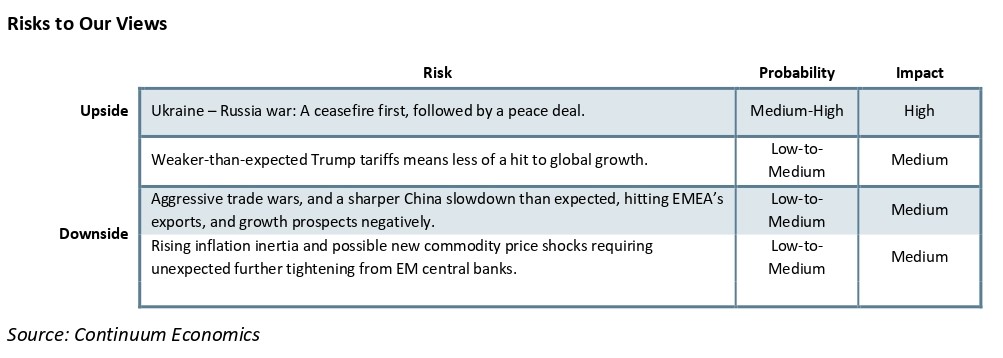
EMEA Dynamics: Complicated Picture Due to Global Uncertainties and Diverse Domestic Dynamics
Country specific factors, inflationary pressures, uncertainty about the global economy, tariff implementation, and pace of the rate cuts by the DM economies continue to rule the EMEA outlook. We think ongoing slowdown in China, unpredictable U.S. economy and trade tariffs by Trump would risk greater uncertainty over the EMEA medium-term prospects.
Inflation remains the major concern for EMEA economies since they remain elevated in Russia and Turkey despite aggressive monetary tightening cycles are still feeding through. Taking into account that the inflation is now below the midpoint target of 4.5%, South Africa reduced the key rate from 8.25% to 7.5% in the last 6 months but halted the cutting cycle as of March 20 given global and domestic uncertainties. We feel Russia will be waiting for the right time to start cutting rates later in 2025 but it would depend on whether a ceasefire followed by a peace deal is sealed in Ukraine. Turkiye will likely continue its cutting cycle unless a spike in inflation is seen.
Apart from Russia, our inflation trajectories remain unchanged for EMEA countries when compared with December outlook. We increased our average inflation forecasts for Russia to 8.6% and 5.3% in 2025 and 2026, respectively, as domestic demand continues to outstrip domestic capacity, military spending remains elevated, fiscal support to military staff and their families are on the rise. We feel there are no signs of a significant inflation slowdown in the horizon yet until a peace deal in Ukraine could lower Russia’s military spending and relieve price pressures.
We think uncertainties about the U.S. and China economies coupled with the extent to which tariff increases are imposed and sustained could darken the EMEA growth prospects in 2025 and 2026. Peace deal in Ukraine and prolonged peace in Gaza will particularly help Russian and Turkish economies to feel relieved.
Figure 1: South Africa, Russia (LHS) and Turkiye Inflation (RHS) (%, YoY), January 2023 – February 2025
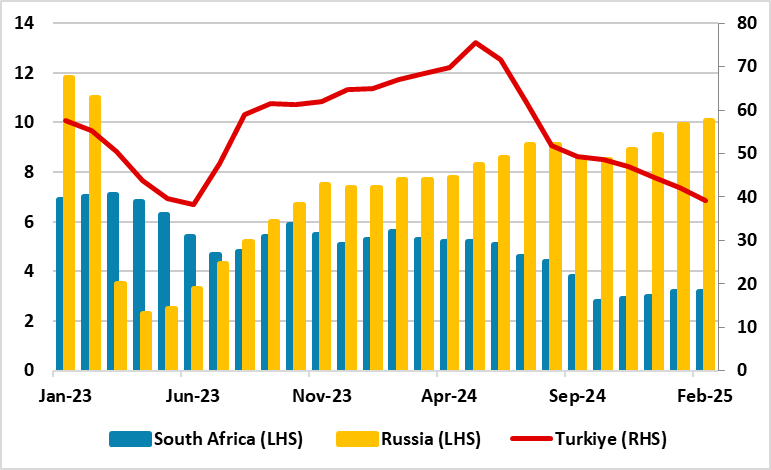
Source: Continuum Economics, Datastream
South Africa
Despite South Africa facing challenges such as declining real per capita growth, rising level of public debt coupled with high unemployment and poverty rates, the economy continues to enjoy inflation remaining below South African Reserve Bank’s (SARB) midpoint objective of 4.5% coupled with rising confidence and a less elevated country risk premium in the bond market. Annual inflation stood at 3.2% YoY in February remaining close to the lower bound of SARB’s target range of 3% to 6% while core inflation hit its the lowest level since December 2021, with 3.4% YoY in February.
Figure 2: CPI, Core Inflation (YoY, % Change) and Policy Rate (%), December 2018 – December 2025
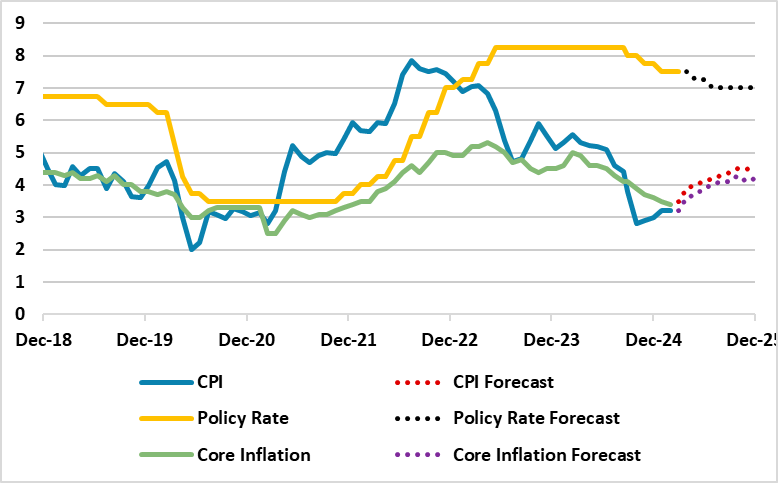
Source: Continuum Economics, Datastream
Despite positive developments, SARB noted in its MPC report on March 20 that that the global economy is not on a stable footing and there are also domestic uncertainties, which put these favorable trends at risk coupled with rising trade tensions and abrupt shifts in long-standing geopolitical relationships. Additionally, we think the major risk on the inflation trajectory is the loadshedding and any acceleration in power cuts the rest of 2025 will ignite a surge in fuel and electricity prices. (Note: Despite power cuts being suspended for 323 consecutive days until February 21, Eskom announced on February 23 that a Stage 6 cut was implemented, followed by a Stage 3 loadshedding on March 7). Energy experts warn that the recent load shedding is a reminder that rolling blackouts are still a threat since Eskom’s generation capacity remains unreliable and unpredictable. We foresee further power disruptions are likely, particularly with the onset of winter when energy demand rises.
In addition to this, 12.7% tariff hike by Eskom for 2025/26, which will be in force as of April 1, coupled with proposed Value Added Tax (VAT) increases announced in the budget, and recent spike in food and housing prices could lift CPI over expectations in H2. (Note: The standard VAT rate will increase to 15.5% from 15% for the 2025-26 tax year, effective May 1, 2025. It will further increase to 16% for the 2026-27 tax year, effective April 1, 2026). We continue to foresee average inflation will hit 4.1% and 4.5% in 2025 and 2026, respectively, supported moderately by lagged impacts of previous tightening, and a relatively stable ZAR. The key for the inflation trajectory will be the government’s determination to address the electricity shortages and financing needs.
Taking into account that SARB started its cutting cycle in September 2024 and reduced the policy rate by 25bps in three straight MPC meetings, we believe the easing cycle was a partial relief for the consumers facing high costs of loans, as well as the automotive industry and the property sectors which have been hit by the elevated interest rates. SARB decided to keep the policy rate stable at 7.5% on March 20 due to global and domestic uncertainties including trade risks, China slowdown, the need for sufficient risk premia to avoid a Rand slide and concerns about the national budget.
As inflation remains below the 4.5% midpoint, we feel this continues to allow more space for rate cuts and we envisage 25 bps cuts in Q2 and Q3 if there are no negative global developments like counter tariff hikes by South Africa after the widely expected U.S. tariffs. A cautious SARB will likely halt in Q4 given risks such as loadshedding and there could be a spike in domestic inflation in H2. We believe data-dependent SARB will continue cutting the rates in 2026, -with a slower pace due to global uncertainties-, and cut by 25 bps in each half of 2026. Our end-year key rate prediction is 7.0% for 2025, and 6.5% for 2026.
Figure 3: SARB Interest Rate Forecast (%), 2018 – 2027
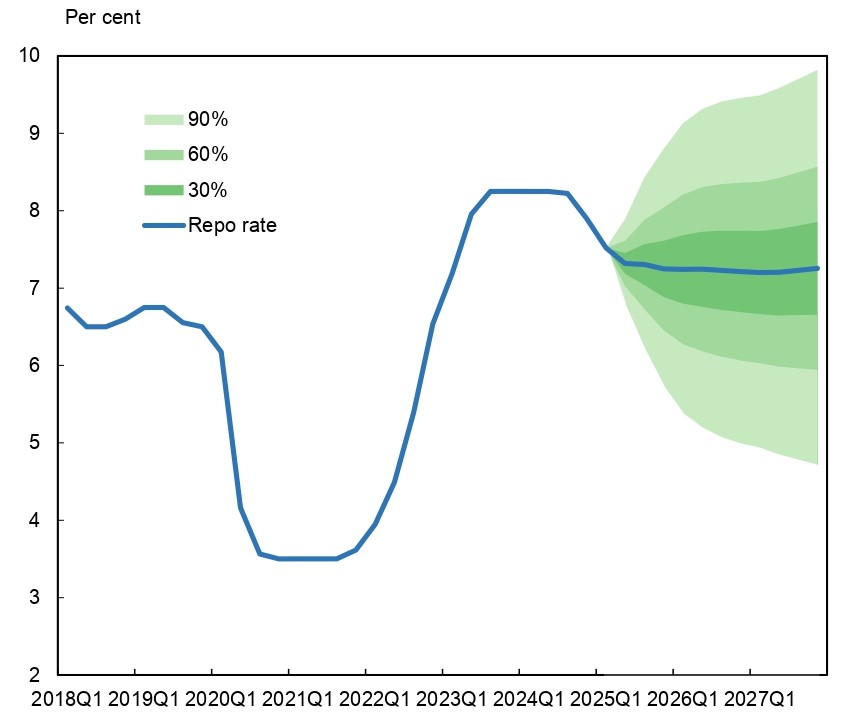
Source: SARB Forecast Report (March 2025)
South African economy grew modestly by 0.6% YoY in Q4 2024 driven by performances by agricultural sector and finance while consumer spending was strong and there was an uptick in private sector fixed investment. We assess the economy will grow by 1.6% and 1.7% in 2025 and 2026, respectively, on the back of improved investor sentiment and rate cuts. (Note: SARB announced the revision of 2025 growth forecast on March 20, from 1.8% to 1.7%, due to weaker demand and ongoing supply challenges highlighting that the risks are to the downside, meaning growth could be lower). We envisage downside risks largely relate to the uncertain external environment and failures in the continuation of structural reforms on enhancing infrastructure investments and fighting loadshedding. (Note: On the manufacturing front, Absa PMI, which edged down by 0.6 points to 44.7 in February, suggested that a sharp rebound in manufacturing output is unlikely in Q1). As mentioned, we feel uncertainty about the U.S. economy, tariffs, and slowing China demand could also cause further risks over the growth trajectory. (Note: South Africa origin metals and ores including platinum, aluminum are used as manufacturing inputs in the U.S., and are among the key risk categories for increased tariffs, which could ignite a fall in South Africa’s exports and suppress growth).
Turkiye
Despite decelerated less-than-expected in Q1 2025, inflation continued to soften particularly after H2 2024 backed by lagged impacts of the tightening cycle, relative slowdown in credit growth, and tighter fiscal stance. CPI cooled down to 39% YoY in February thanks to 30% hike in minimum wage in January coupled with a recent Turkish regulation lowering patients’ co-payments at public hospitals and a relative Turkish lira (TRY) stability, which helped relieving price pressure. Despite the decelerating pace is slower in last three months due to sticky services inflation and deteriorated pricing behavior, we envisage that inflation will continue to cool off backed by moderate slowdown in domestic demand and credit growth. This inflation slowdown will likely be with a slower pace in H2, and the extent of the decline will be determined by administrative price adjustments such as wages and rents, and TRY volatility.
It is worth mentioning that President Erdogan recently said that he wants to see the inflation rate coming down and expects more rate cuts, we think the economic administration team could be under pressure since it will be difficult to grind inflation rate from 40%s to 20%s rapidly, taking into account that inflation becomes stickier requiring high interest to remain for some time. It appears it would be necessary to make concessions on growth, particularly in 2025. (Note: The arrest of Istanbul mayor Imamoglu on March 23 could trigger market losses, TRY to lose value, and a temporary inflationary impacts particularly in Q2. The protests continue in Turkiye as all major cities witness gatherings despite restrictions which is the first powerful reaction after Gezi protests in 2013, and it is difficult to see how this will evolve and affect the domestic economy in the next months).
Our forecasts for the annual average inflation remain 32% and 20% in 2025 and 2026, respectively. We anticipate an ongoing wage-inflation spiral, deteriorated pricing behavior, and geopolitical risks will keep inflation pressures alive the rest of 2025 and 2026. If Ukraine-Russia war will come to end, this will be positive for Turkish inflation outlook.
We expect cautious CBRT will continue its cutting cycle in 2025 unless there is a sustained surge in the underlying trend of monthly inflation is observed, as recently emphasized by CBRT governor Karahan. MoM inflation which stood at 2.27% in February demonstrated that monthly inflation is still high signaling CBRT will have to remain highly attentive to inflation risks. We foresee the rate cuts to continue in 2025 (250bps cuts at each MPC in 2025), and our end year key rate prediction for 2025 and 2026 remain at 30% and 19%, respectively. We envisage CBRT will continue cutting rates in 2026 to 19%, but with a slower pace due to global economic uncertainties and geopolitical risks. It is worth mentioning that CBRT governor Karahan repeatedly signaled that CBRT would do whatever it takes to avoid any lasting deterioration in inflation and also said easing cycle will resume until a spike in inflation. MoM inflation readings will also be key, as CBRT will want to avoid reigniting inflation with too aggressive rate normalization. The pressure is also growing from Turkish exporters and industrialists to continue cutting cycle at pace, will be an issue to consider for CBRT in 2025.
Another headwind for Turkish economy in addition to inflation is the wage-inflation spiral. More than half of Turkiye’s working class earns the minimum wage, and Turkish workers continue to suffer from galloping inflation since the government increased minimum wages by 30% in January 2025, which is below the inflation rate, to reduce aggregate demand and restrain price pressures. Despite Turkish employees pushing for a solid minimum wage hike to cope with higher cost-of-living, the hike did not satisfy workers and caused limited social unrest, while it proved the government’s determination to rein in chronic inflation.
Figure 4: CPI, Core Inflation (YoY, % Change) and Policy Rate (%), January 2015 – December 2025
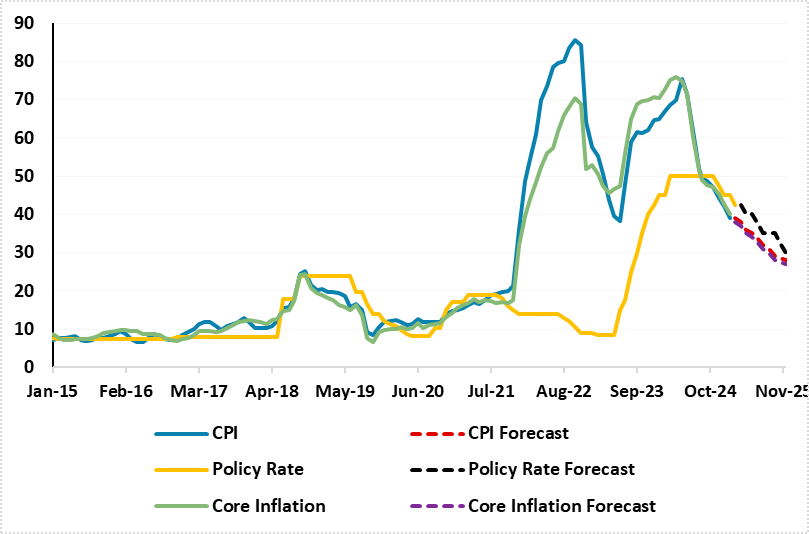
Source: Continuum Economics
On the growth front, as we correctly expected, Turkish economy expanded by 3.2% YoY in 2024 backed by accelerated private consumption and robust investments, despite the weight of high interest rates. We feel tight monetary and income policies will continue to suppress domestic demand the rest of 2025 bringing growth to 2.6%. (Note: We think there is still a downside risk to the growth trajectory considering all the tightening measures in place). On the downside, growth will be under pressure due to contractionary fiscal actions and additional macro prudential policies to fight against the elevated inflation. Additionally, adverse geopolitical developments, including increases in tariffs and continuation of Russia-Ukraine conflict will be the risk factors.
A drop in the inflation rate and rate cuts could boost confidence and growth would rise back toward potential of 3.5-4% after 2025, hitting 3.5% in 2026. On the upside, falling headline inflation in H2 could feed into backward-looking inflation expectations, easing price pressures.
Figure 5: GDP Growth (%, YoY), Q1 2020 – Q4 2024
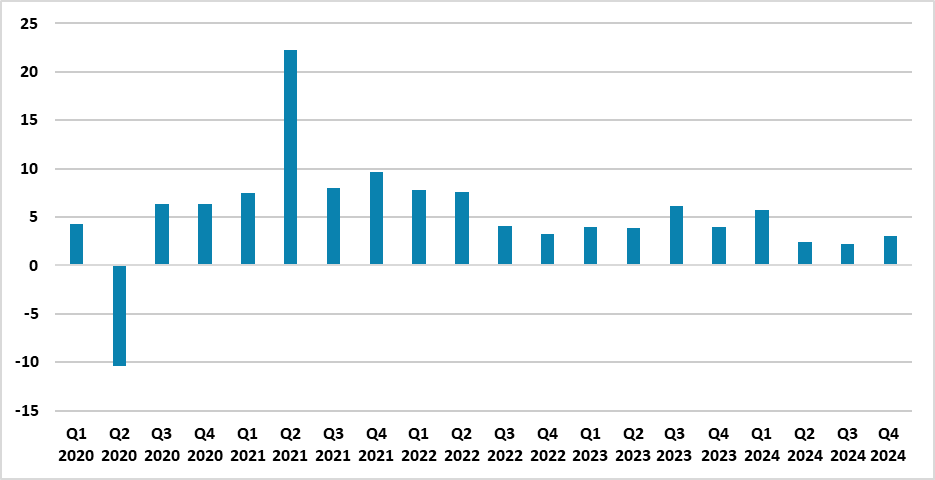
Source: Continuum Economics
The rest of 2025 and 2026 will be significant for the Turkish economy from every angle while the key will be aligning fiscal, monetary, and incomes policies, which need to work together during the disinflationary process. We think the recent arrest of Istanbul mayor Imamoglu could risk the disinflationary process particularly if TRY plunges severely and investors leave Turkish market due to risks. As noted, it is difficult to predict how this will evolve due to political uncertainties.
Russia
Russian economy is currently being squeezed due to inflation spiking. The inflation rate hit 10.1% % YoY in February, -the highest reading since February 2023- due to huge military spending, labor shortages, supply-chain disruptions and import suppression. Despite the lagged impacts of monetary tightening, the economy remains overheated as the growth in domestic demand is still significantly outstripping the capabilities coupled with strong fiscal support to military staff and their families and elevated inflation expectations. There are constant surges in services and food prices. The war in Ukraine continues to dominate all outlooks as it creates an increasing financial burden on Russia. The overall environment for doing business in and with Russia remains unfavorable.
Given mentioned risks, Central Bank of Russia (CBR) significantly hiked its 2025 inflation forecast to between 7% and 8%, from 4.5% to 5% in February. When compared with the December outlook, we also increased our average inflation forecasts to 8.6% and 5.3% in 2025 and 2026, respectively. (Note: We feel inflation will peak with 10.4%-10.5% in April). Inflation is projected to moderately slow down after late Q3/Q4 as tight monetary policy will likely affect bank lending and private consumption, but a ceasefire followed by a peace deal in Ukraine will be critical for the inflation trajectory.
Despite inflation remains high, we feel the pass-through of the earlier RUB weakening to prices, which increased in December 2024, partly soothed in Q1 and helped inflation trajectory. RUB gained about 28% of its value against the USD in 2025 on expectations of easing tensions between Russia and the U.S. and a peaceful settlement in Ukraine. We think acceleration in inflation is partly constrained by a stronger RUB. Despite this, we expect RUB would remain volatile in 2025 since inflationary pressures won’t likely start to soften and macroeconomic instability will remain substantial. A ceasefire in Ukraine could underpin the RUB while a full RUB recovery requires a peace deal together with the decision to lift sanctions against Russian economy, which could take years.
CBR kept the policy rate constant at 21% on March 21 for the third consecutive time to combat price pressures, and signaled that it is unlikely that further tightening is needed for disinflation stating that current inflationary pressures have decreased but remain high. (Note: In line with this, CBR governor Nabiullina recently emphasized that price pressure remains high, and inflation expectations elevated meaning that CBR should maintain tight monetary conditions for a long period). CBR will likely start considering cutting rates if inflation starts softening, RUB stabilizes and inflation expectations would converge to CBR’s forecasts. Our 2025 end-year key rate forecast is 19% and 12% for end-2026. We are of the view that risks to the inflation outlook remain to upside as the fiscal policy is making a big contribution to domestic demand, coupled with high military spending, rising wages and surging inflation expectations, while there are no signs of a significant inflation slowdown in the horizon yet.
We foresee a Russia-friendly deal in Ukraine following talks between the U.S. and Russia could ease some pressure on inflation and alleviate demand-supply imbalances. CBR could consider reducing the rates afterwards, but this will depend on how peace negotiations will proceed in spring 2025.
Figure 6: CPI, Core Inflation (YoY, % Change) and Policy Rate (%), January 2015 – February 2025
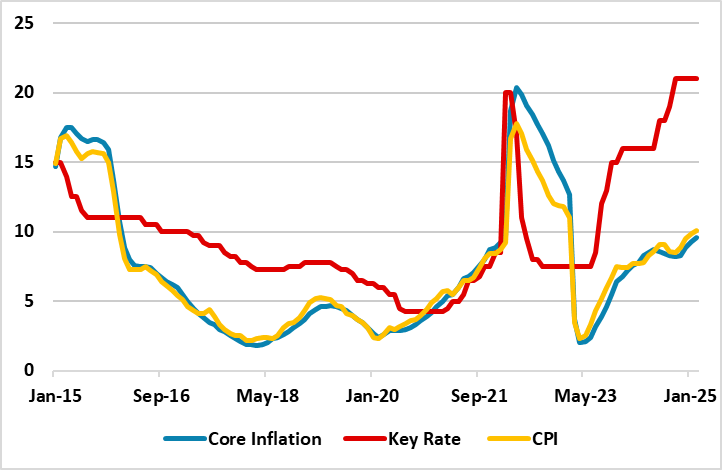
Source: Continuum Economics
The main driver for the GDP growth remains the surge in military spending, supported by the improved consumer demand amid greater outlays on social support, higher wages and strong fiscal stimulus. There is an increased public spending in war-related industries and construction in Russia as public spending is at unprecedented levels as around 40% of the government budget is spent on the war. We envisage growth to hit 1.6% and 1.5% in 2025 and 2026, respectively, which is significantly less than 2024 figure, as we foresee a peace deal declared later in 2025 lowering Russia’s military spending and fiscal support and as monetary tightening is still feeding through.
On the war front, we foresee two major scenarios in Ukraine. First one is a Russia-friendly peace deal (70% probability) securing that Russia continues to annex areas in and around four Ukrainian oblasts that it occupied, no NATO membership for Ukraine, and no foreign troops in Ukrainian territory. President Putin might give some concessions with Russia allowing limited flexibility on what occupied land in Ukraine are kept by Ukraine depending on the terms of the peace-deal. We feel a direct negotiation process between U.S. and Russia taking place, which will be followed and then agreed by Kyiv administration.
Second scenario is based on the war continuing (%30 probability) after ceasefire talks fail since Putin insists on his peace terms. If President Zelenskyy and President Trump do not find a common ground, Europe steps up and helps Ukraine financially and militarily, and the war will likely continue, which will be hard without U.S. support. In the meantime, Ukraine will probably continue to lose more ground. A ceasefire in 12 months or so is likely under those circumstances, with Russia gaining more land and a weaker Ukraine. Europe could fill the U.S. financial gap for a number of years, but without U.S. military support a Ukraine win will be almost impossible.
If a ceasefire takes place (and an effective peace deal is sealed afterwards) in 2025/2026, the Russian economy will feel the relief since RUB will likely strengthen, average headline inflation will soften, and fiscal pressure will ease particularly if sanctions will be lifted.